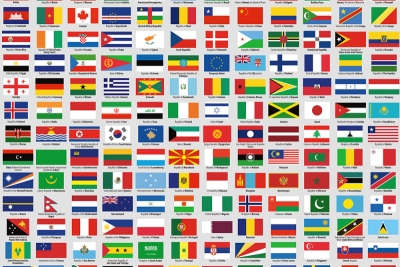
FLAGS
Historically, army leaders carried flags into battle as a rallying point for the soldiers. Today, flags are used to decorate buildings, mark public events, start races, honour the dead, or to spell out messages or warnings from one ship to another. But by far the most recognizable ones are national flags – vibrant in colour and unique in symbolism. Organizations and citizens fly the flag for their countries, building up a strong sense of identity, pride, and unity.
- AUSTRALIA
The flag features a combination of the United Kingdom’s flag, the Commonwealth Star (with its points symbolizing the original states of Australia), and the Southern Cross constellation (only visible in the Southern Hemisphere).
- SOUTH KOREA
A red and blue Yin Yang symbol on the South Korean flag represents the Chinese philosophy that everything in the Universe has an opposite. The four surrounding trigrams (groups of three lines) represent the ideals of balance, circulation, harmony, and symmetry.
- INDIA
At the centre of the tricolour (three colours) is the ashoka chakra, meaning “wheel of law”. This symbolizes the hope that the country will continue to move forward peacefully.
- USA
This flag is nicknamed the “Stars and Stripes”. The 50 stars represent the states of the Union, while the red and white stripes are the 13 original colonies to join the Union.
- KENYA
Since 1963, Kenya’s flag has been dominated by a shield and spears, used by the country’s Masai people. This symbol shows how the nation is determined to defend its freedom.
- MEXICO
Traditionally, these colours had religious and military connotations, but the new meanings are defined as hope (green), unity (white), and the blood of heroes (red). The central image is a symbol from an earlier Aztec heritage.
- GERMANY
During the Napoleonic wars of the 19th century, German soldiers wore black uniforms with red braid and gold buttons. These became the country’s official colours, appearing on the national flag. Public buildings often fly the flag vertically.
- IRELAND
This has been the flag of Ireland since 1919. The orange stands for Protestants, the green for Catholics, and the white for the peace between them.
- SPAIN
This young flag was established in 1981. On the left-hand side, where the flag gets hoisted, is the Spanish coat-of- arms, which includes the royal seal.
- JAMAICA
The flag of this Caribbean country shows a gold diagonal cross, which embodies the shining sun, green, for the fertile land, and black, which represents strength and creativity.
Picture Credit : Google



